Clay became her ‘one black crayon’
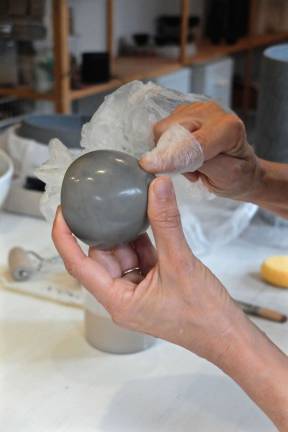
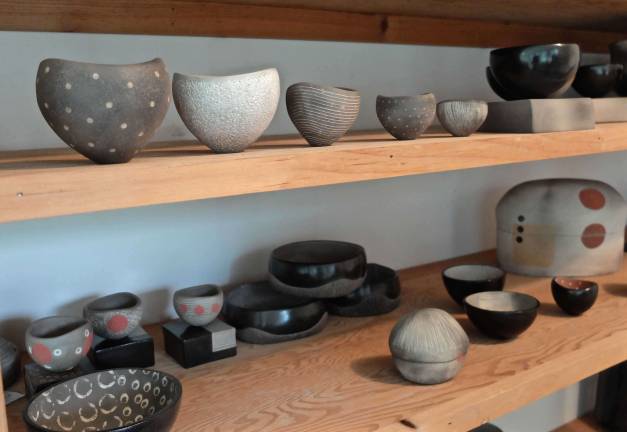
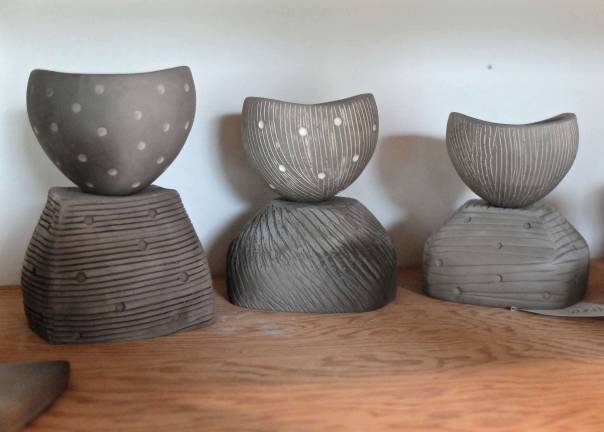
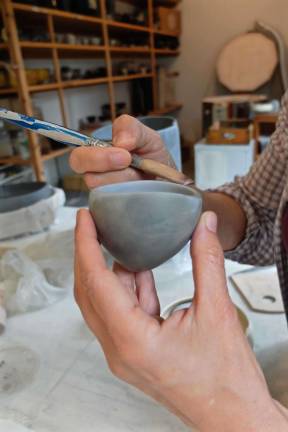
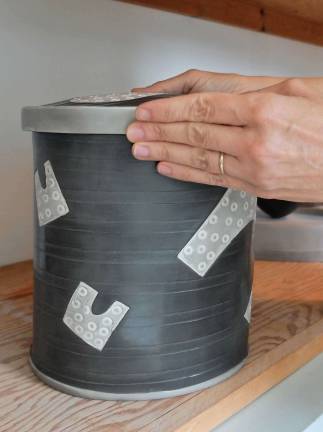
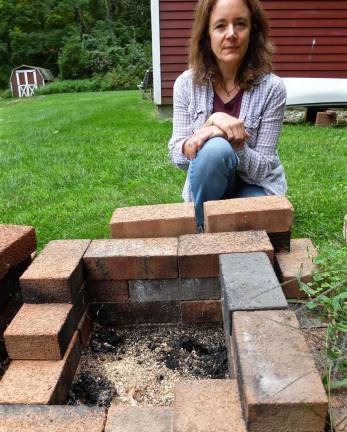
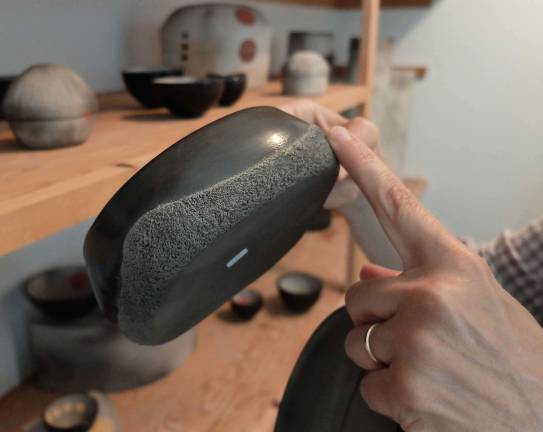
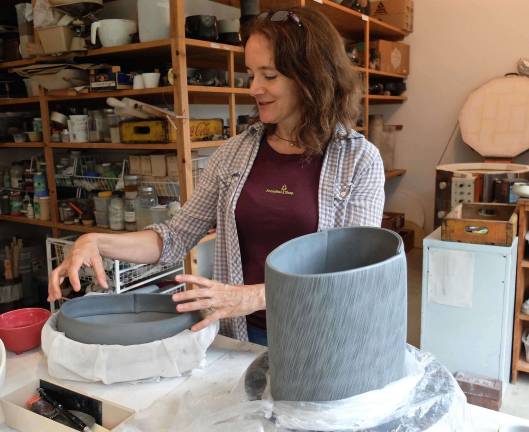
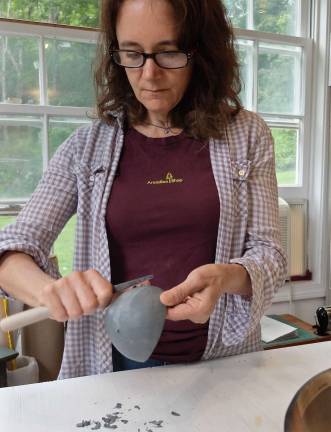
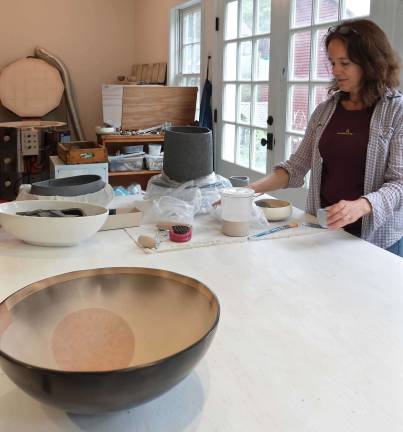
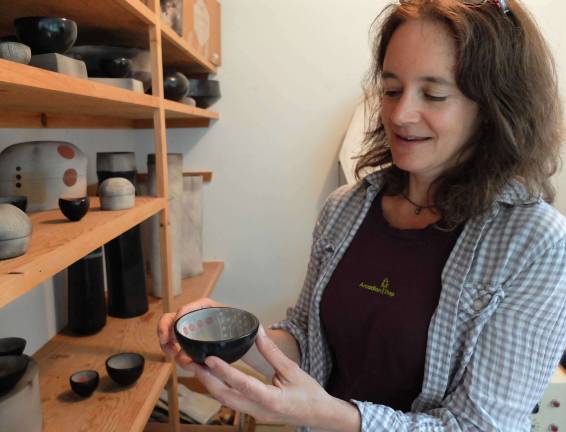
In ceramic vessels, capturing the quiet, detailed beauty of nature
By Melissa Shaw-Smith
Paula Shalan’s strong fingers sculpt the air as she describes how she came to build pots. She struggled with dyslexia during childhood, remaining silent, expressing herself through drawing and painting, and making collages with her mom. She went on to thrive academically by bringing a singular focus to her work. Today, here in her studio in a small town in the Berkshires, she still puts her thoughts and ideas into the vessels she creates, loving the sensual plasticity of clay––the feel of it in her hands.
Arrayed on shelves in her workroom are delicate pinch pots that fit in your palm and whose organic shapes and textures would look at home in the woods; large bowls skillfully pinched into shape from coils of clay; and slab-rolled cylinders, joined together with pronounced seams, or mimicking wooden shaker boxes.
Shalan went to Sarah Lawrence College, initially to study early childhood education and painting. Her first ceramic teacher, Mikhail Zakin, a renowned clay artist herself, would walk around with a rolling pin, smashing students’ work that she thought too fussy, encouraging them to make art out of the contorted forms. From her, Shalan learned to let the clay direct her experimentation. Zakin also taught her to make multiples of the same thing, learning from each piece. Shalan uses relatively simple hand building techniques––coiling, pinching, or rolling out slabs to make her pots––but in the thousands of pieces she has made over 30 years, she has elevated the humble pot to a refined work of art.
In a not uncommon moment of doubt as an art student, Shalan took a break to do something more meaningful. She baked a loaf of bread every day, wove on her loom, and learned to throw a pot to have something to eat rice out of. Drawn to the functional aspect of ceramics, she put down the paintbrush and picked up the clay that would become her life’s medium. “I love the entire history of humans making vessels,” she says. Now, her work has come full circle––it’s vessel-form but non-functional.
In 2016, Shalan won the Sustainability Award at the prestigious Smithsonian Craft show. She uses a locally dug white earthenware clay, builds by hand, and pit fires her work using repurposed woodchips. Early in her career, working with children, she noticed that if you give them fewer choices, they experiment more. “I apply that to my own practice,” she says. “I need to just use the black crayon in the Crayola box.”
There are many steps in Shalan’s creative process, so she works on multiple pieces at a time. Using a knife blade, she pares away the faint impression of finger marks on a leather-hard pinch pot. Moving on to a bone-dry pot, she sands it to further smooth the surface. Next, she brushes on several layers of homemade terra sigillata, a thin clay slip of tiny clay particles suspended in water. While it’s still damp, she wraps a plastic bag around her finger and polishes it, bringing out a lustrous glow and revealing the subtle nature of the clay––one of the signature looks of her work. Just as in nature, she likes to vary the surface of her vessels. She may add texture by using a tool to mark the surface, drawing on the intricate patterns found in a piece of bark or a seed pod.
When it came to firing her work, she knew she wanted to retain what she calls the clay’s earth-warmth. She asked herself, “How could I fire my work and have it look like it does at its wet stage? I knew I didn’t want to cover the clay with glaze, but I also knew that I didn’t want it to be stark clay. I wanted a little more depth of surface.” She began experimenting.
Outside the barn, Shalan has built a simple pit surrounded by bricks. In an ancient technique known as pit or smoke firing, pots are buried in woodchips that are set on fire and allowed to burn for 24 hours. The less oxygen available, the more the flame steals oxygen from the clay, depositing carbon throughout the clay in soft smoky gray blue or brown patterns. This kind of atmospheric firing is unpredictable, Shalan explains, which is part of its beauty.
In the last few years, as her work has become more graphic, Shalan wanted to go beyond the smoky disturbances. By wrapping pots tightly in layers of newspaper and foil, she has been able to create a satiny even tone from the smoke on her terra sigillata pieces. She’s also found underglazes partially resist the smoke so that she can introduce hints of color into her work. “The way the smoke absorbs into different clays or different surfaces is basically what I’m playing with,” she explained. The sophisticated results are not normally associated with this primitive technique and have garnered her acclaim in the world of ceramic artists, and collectors who look for her new work each year.
Raising young kids and finding time for her art was not easy. Luckily, when the family settled in Massachusetts, Shalan discovered that IS183 Art School of the Berkshires was a five-minute walk from home. She helped develop and run their Young Artist Program where she taught for many years, juggling it with studio time.
Having to bide her time while her kids were growing up has paid off. When she was finally ready to apply to the top, juried craft shows in the country, her mature aesthetic and craftsmanship secured her acceptance. Initially the steep booth fees made her skeptical that she would do more than cover her costs. Now her work is carried in several high-end galleries, and she does a number of shows a year where she sells well.
“I’m always learning and listening to the process. One black crayon out of the Crayola box, if you’re stuck with that for 30 years, you’re going to discover some pretty interesting things you can do with that crayon.”